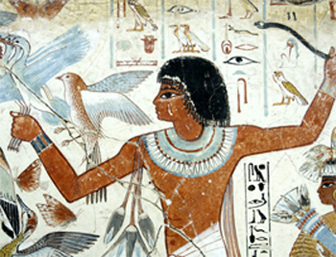2.3 The nature of artistic practice
A related aspect of the problem concerns the nature of the characteristic range of practices in question, for all known human societies have evolved versions of these practices. The paradox is that it took the development of the western category of ‘art’ to the point that literally anything could be classifiable as a ‘work of art’ for the category to embrace the cultural products of the whole of humankind. While ‘art’ remained an exclusive category, subject to the exercise of certain restricted skills, on certain restricted materials, to express certain restricted themes, it could not perforce embrace practices that operated in different ways upon different material to express different ideas. Only when art’s exclusivity was transcended could it become a de facto universal category.
Once it has become that, it would be completely perverse to deny the status of art to, say, a four thousand year old image of a man that does not conform to the classical canon of western representation, produced anonymously, for ends we imperfectly understand (let us call him Nebamun) (Figure 6).

We live in a relativistic and commonly accepted liberal culture. In the second half of the twentieth century, partly as a reaction against the universalising claims of modernist theory that all art could be traced down to a common formal essence of ‘significant form’, recent art history and cultural theory has put great emphasis on concepts of ‘difference’. In the name of diversity, and as a form of intellectual, even political, resistance to the Eurocentric bias that was often implicit in the notion of ‘humanism’, many art historians have sought to emphasise the difference between canons of representation. To give a crude example, historians have ceased to disparage Indian or Chinese art for its failure to conform to Western decorum, as their nineteenth-century predecessors so often did.
However, this openness to the relativity of cultural and aesthetic value can also result in a blindness to the peculiarity of what we are doing when we ‘appreciate’, or even feel ‘interest’ in the products of remote cultures. How do we do it? How do we recognise similarity-in-difference? Thierry de Duve once suggested a notion of ‘transcendental materialism’ to get at this point. Whether or not that concept holds water, there can be little doubt that an over-emphasis on relativity and difference often makes its gains at the expense of notions of a common or shared ‘humanity’. Yet when we encounter phenomena such as ancient Egyptian art, one of the most important things that seems to bridge the gulf between ourselves and the makers of these ancient pieces is precisely such a common humanity. Were there only ‘difference’ between us, it would be hard to make any sense at all of things so remote in both time and space. The miracle is that these remote things are precisely not completely alien.
John Baines has convincingly established that the practices we refer to as ‘ancient Egyptian art’ were not completely client to other social demands – to do with religion, for example, or social stratification, or exercising power. There is enough going on that is specific to them to warrant the claim that there existed a relatively independent tradition of ‘art’ making, involving the exercise of aesthetic judgement at the levels of both production and consumption, and extending over centuries. ‘Egyptian art’ was, so to speak, a relatively autonomous practice within the constellation of Egyptian culture in the broadest sense, that is, including religion, politics, daily life, and so on.
However, it is probably mistaken to conceive of ‘art’ as a universal concept, if only because of the evolutionary vicissitudes and differences to which the various products and practices of art have been subject. It is patently clear that even as we talk about and admire ‘ancient Egyptian art’, it is not ‘our’ art. It is not, then, that there is an ‘essence’ of art centred upon exercising aesthetic judgement over and above making merely utilitarian things, but that there is enough of an overlap – an ever-changing overlap, it must be said – between widely different practices to permit a category such as ‘art’ to be used sensibly to describe a performance by Joseph Beuys talking to a dead hare and a three thousand year-old fragment of painting from a tomb-chapel on the west bank of the Nile.
It may be useful here to think of Wittgenstein’s concept of ‘family resemblances’. To take a simple example, Wittgenstein pointed out that there was no essence of the concept of a ‘game’, but that the various things we conceive of as ‘games’ were united in a manner analogous to the way in which related people exhibit a ‘family resemblance’. So too with art. All human societies have evolved practices and products we can now regard as ‘art’, but this does not mean there is an ‘essence’ of art that manifests itself in different ways, that ‘art’ is some transcendent universal – only that there is a family of related practices which, in this culture (which, of course, has in important respects now become globalised), we have collected under the concept ‘art’.
